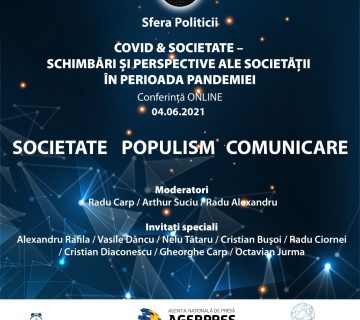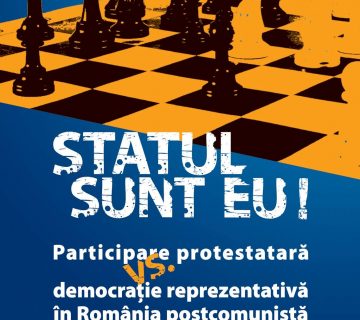Defining and Origin of Aversive Racism
Racism remains a deeply entrenched problem in contemporary society, despite significant progress made in recent decades towards equality and inclusion. Social and legislative transformations have not eradicated prejudice and discrimination but have caused them to take on new forms, often more subtle and difficult to recognize at first glance[1]. One of these forms is “aversive racism,” a concept introduced by sociologists John Dovidio, Samuel Gaertner, and Tamar Saguy.[2]
Aversive racism is a concept from social theory proposed by Samuel L. Gaertner and John F. Dovidio in 1986. It describes negative evaluations of racial or ethnic minorities through a persistent avoidance of interaction with other racial and ethnic groups. Unlike traditional overt racism, characterized by hate and discrimination, aversive racism is characterized by ambivalent and complex attitudes toward other races. These attitudes are often the result of unconscious beliefs formed in childhood. Subtle racist behaviors are typically directed against African Americans, Muslims, and Roma people, with workplace discrimination being a common example of aversive racism.[3]
The term “aversive racism” was introduced to describe a subtle and indirect form of racial prejudice. Prior to the introduction of this concept, research had largely focused on overt or “old-fashioned” racism, which involves ideologies of racial superiority, segregation, and open discrimination. The civil rights movement of the 1960s and the adoption of anti-discrimination legislation reduced overt manifestations of racism, but did not completely eliminate racial prejudices. These prejudices began to manifest in a more subtle and indirect form, leading to the necessity of redefining and expanding the concepts of racism to include these new forms of prejudice.[4]
Aversive racism describes the attitudes and behaviors of those who endorse egalitarian beliefs and deny any racial prejudices, yet act differently when interacting with members of minority groups. This type of racism manifests through subtle behaviors, such as avoiding direct interactions and maintaining social distance from minorities. [5]Individuals who exhibit aversive racism often justify their discriminatory behaviors through non-racial rationalizations, thereby contributing to the perpetuation of prejudices without being aware of it.
The Manifestation of Aversive Racism
Aversive racism is manifested through negative evaluations of racial and ethnic minorities, characterized by the avoidance of direct interactions with these groups and the maintenance of ambivalent and complex attitudes towards them. Individuals who exhibit this type of racism publicly endorse ideas of equality and diversity but maintain subtle attitudes and behaviors that disadvantage minority groups. These unconscious biases are expressed through indirect behaviors, such as avoiding interactions with members of minority groups or supporting policies that restrict their access to resources and opportunities. [6]
For instance, an employer might publicly claim to support diversity but unconsciously favor majority candidates during the recruitment process, justifying their choice through “cultural compatibility.” In another example, a teacher might claim to treat all students equally but may provide less attention or support to students from minority backgrounds, assuming they are less capable. In everyday life, a neighbor might avoid eye contact or conversations with a recently moved immigrant family, citing reasons such as “being busy” or “lack of time.”[7]
Aversive racism also manifests in subtle behaviors in daily life. In stores, employees might scrutinize ethnic minority customers more closely, assuming they are more likely to steal. At the workplace, minority employees may be excluded from advancement opportunities, perpetuating inequalities and maintaining the privileges of the majority group.
A pertinent example is how minorities are treated within the educational system. Minority students may face marginalization from peers and teachers, affecting their academic performance and self-esteem. Additionally, minorities may encounter difficulties in accessing adequate educational resources and personal development opportunities, contributing to the perpetuation of inequalities and limiting social mobility.
In neighborhoods, minority families might be treated with suspicion and isolation by majority neighbors, hindering their social integration. This marginalization can have long-term negative effects on social cohesion and create significant barriers to building inclusive and equitable communities. Aversive racism is an insidious form of prejudice that affects various minority groups through subtle exclusion and discrimination. Recognizing and understanding this form of racism is crucial for developing effective strategies to combat it and promoting equality and inclusion in modern society.
Aversive racism represents an insidious form of prejudice that persists in modern societies, affecting various minority groups through subtle exclusion and discrimination. The introduction of the concept of aversive racism has fundamentally changed the understanding of the dynamics of modern racism, highlighting the need to address not only overt forms of discrimination but also the subtle and indirect manifestations of racial prejudice.
To combat this type of racism, it is necessary to recognize and understand the subtle ways in which prejudice manifests. Intercultural education, public awareness, and the promotion of positive interactions between ethnic groups are important steps in reducing prejudice and fostering a more equitable and inclusive society. Only through concerted and sustained efforts can we build a more equitable and inclusive society for all its citizens.[8]
Manifestations of Aversive Racism in Romania:
A Quantitative Analysis of Majority Perceptions and Attitudes Towards Ethnic Minorities
Methodology
This study employed a quantitative research method. The quantitative approach involves the collection of numerical data that is statistically analyzed to describe, explain, or predict certain phenomena. In contrast to qualitative research, which relies on detailed descriptive data, quantitative research uses large samples and predetermined tools (e.g., questionnaires, scales) to test hypotheses and generate generalizable results.[9]
Participants
To achieve representative results at the population level, the sample of subjects must be rigorously selected. This study used a probabilistic sample of 400 adult Romanian individuals, evenly distributed across four counties (100 from each county). Probabilistic sampling, where all members of the population have an equal chance of being selected, ensures representativeness and reduces selection bias (Gravetter & Forzano, 2018). Subjects were randomly selected to achieve diversity based on relevant socio-demographic criteria (gender, age, residential environment, education). The counties where the study was conducted are: Brăila, Galați, Constanța, and Buzău.
Research Instrument
Data were collected using a standardized questionnaire, a valid and frequently used quantitative tool in social sciences. The questionnaire was developed based on the theoretical framework studied and included 15 closed-ended questions with responses on a Likert scale from 1 to 5. The Likert scale allows for nuanced quantification of opinions and is ideal for measuring attitudes.[10] Standardized questionnaires ensure data consistency and facilitate statistical analysis.
Procedure
The questionnaires were administered from January to February 2024 using a direct, face-to-face method by trained operators. Direct administration maximizes response rates and allows for clarification of any misunderstandings. Participation was voluntary and anonymous to ensure sincerity.
Questionnaire Items
- Do you believe that ethnic minorities in Romania have too many rights and unearned benefits?
- Do minorities take too much advantage of our social welfare system, while ordinary Romanians receive too little?
- How comfortable would you feel if a Roma individual moved in next door?
- How comfortable would you feel if a Muslim immigrant moved in next door?
- Do you believe that “positive discrimination” policies in favor of ethnic minorities should be abolished?
- Do you think that ethnic minorities often try to exploit their special status?
- Do Roma students receive university places without deserving them, while Romanian candidates are rejected?
- Do immigrants steal jobs from Romanians?
- Do the culture and values of ethnic minorities threaten traditional Romanian culture?
- Do ethnic minorities receive too much financial support from the Romanian state?
- Should Romanians always have priority over minorities in employment?
- Should Romania limit the number of immigrants coming here?
- Do you support the idea that each ethnicity should remain separate and maintain its cultural purity?
- Are Roma largely responsible for crime in Romania?
- My overall opinion of ethnic minorities in Romania is positive.
Detailed Statistical Interpretation of Questionnaire Data
Descriptive Analysis of Data
I. Perception of Minority Rights and Benefits
Question 1: Ethnic minorities in Romania have too many rights and unearned benefits.

The mean score of 3.8 and the agreement of 60% of respondents indicate a significant perception that ethnic minorities benefit from unjustified rights and advantages. This perception generates feelings of inequity and frustration among the majority population. Such resentments contribute to the perpetuation of stereotypes and discrimination, impacting social cohesion and exacerbating inter-ethnic tensions.
Question 2: Do minorities take too much advantage of our social welfare system?
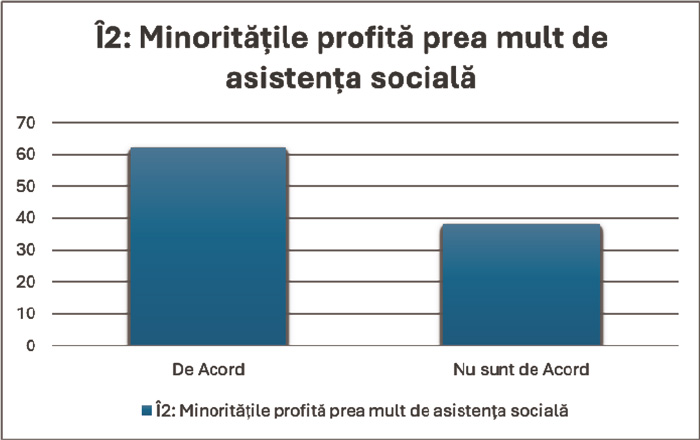
The responses reveal that 62% of participants agree or strongly agree with the statement that minorities excessively benefit from the social welfare system, while ordinary Romanians receive too little. The mean score of 3.7 underscores a significant perception of inequity in the distribution of social assistance. This perception of unfair distribution can generate feelings of resentment towards minority groups and the social welfare system.
Question 10: Do ethnic minorities receive too much financial support from the Romanian state?
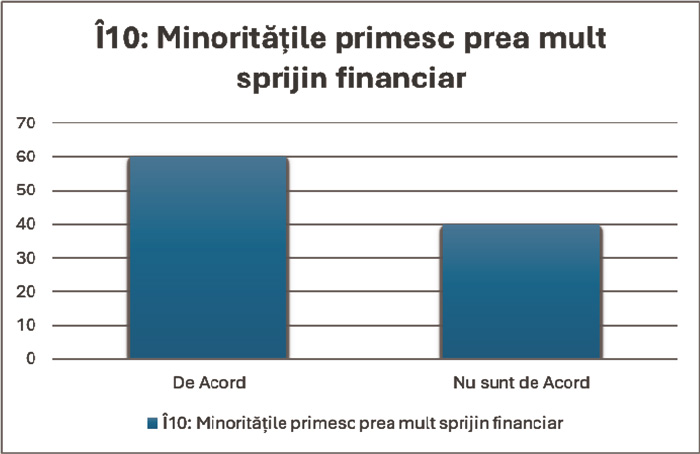
The mean score of 3.3 and the agreement of 60% of respondents indicate a widespread perception of inequity in the distribution of public financial resources. The resentments arising from this perception can lead to social polarization, reinforcing barriers between ethnic groups and negatively impacting social cohesion. Perceptions of favoritism can exacerbate prejudices and discrimination.
II. Attitudes Towards Immigration and Cultural Diversity
Question 4: Discomfort Towards Muslim Immigrants

The mean score of 2.3 and the agreement of 55% of respondents reflect a pronounced reluctance to accept Muslim immigrants as neighbors. Negative stereotypes and prejudices related to cultural and religious differences amplify these negative perceptions, generating discomfort and social exclusion. Such attitudes can significantly impact the integration of immigrants and social cohesion.
Question 12: Should Romania limit the number of immigrants?
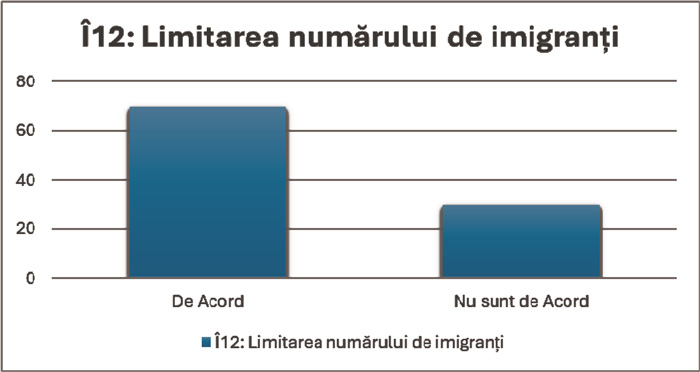
The mean score of 4.0 and the agreement of 70% of respondents indicate strong opposition to immigration. Concerns related to competition for resources and jobs, as well as issues regarding cultural identity and national security, fuel this opposition. Such sentiments can contribute to xenophobia and discriminatory behaviors.
Question 13: Cultural segregation

The mean score of 2.8 and the agreement of 40% of respondents indicate moderate support for cultural segregation. Concerns about losing cultural identity and a desire to protect traditions may contribute to a preference for maintaining cultural separation. Such preferences for cultural segregation can limit interactions and collaboration between ethnic groups, thereby perpetuating social tensions.
Question 9: Cultural threats

The mean score of 3.4 and the agreement of 55% of respondents suggest a significant perception that ethnic minorities threaten traditional Romanian culture. Concerns about the loss of cultural identity may generate a defensive reaction, reinforcing negative stereotypes and affecting inter-ethnic relations. This perception of cultural threat can undermine efforts to promote inclusion and multiculturalism.
III. Competition for Resources and Employment
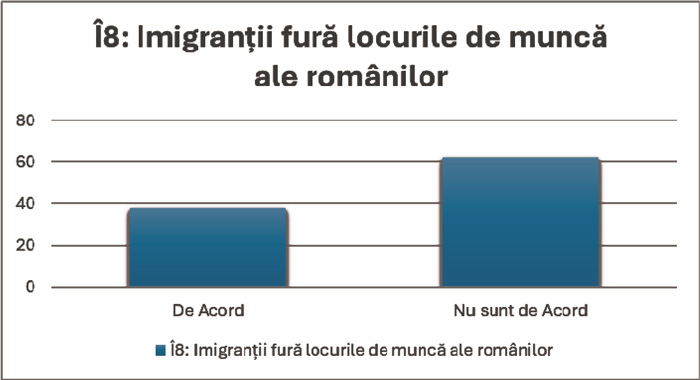
The mean score of 3.2 and the agreement of 38% of respondents indicate a perception of unfair competition in the labor market between immigrants and the local population. Resentments towards immigrants, exacerbated by challenging economic conditions, can lead to social tensions and discriminatory behaviors. The perception of unfair competition highlights concerns that immigrants may be seen as displacing local workers or creating an uneven playing field in the job market.
Question 7: Roma access to higher education
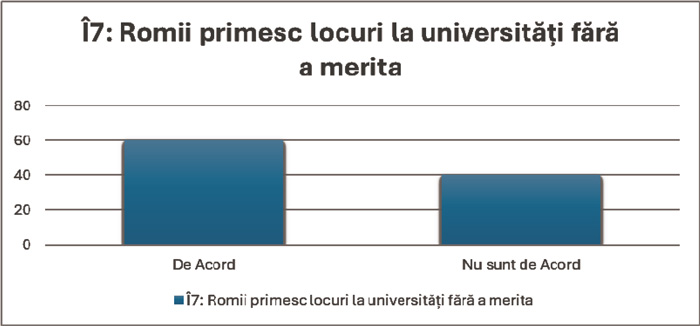
The mean score of 3.1 and the agreement of 60% of respondents reflect a perception of inequity in access to higher education for Roma individuals. This perception indicates that a substantial portion of the population believes Roma may receive unjustified advantages in the higher education system. The perception that Roma students benefit from unfair advantages in accessing higher education can generate significant resentment. This belief is often rooted in broader concerns about fairness and equity in educational opportunities, and may be exacerbated by existing stereotypes and social biases.
Question 11: Employment priority for Romanians

A mean score of 3.6 and the agreement of 60% of respondents suggest a strong “us versus them” perspective regarding employment. Concerns about competition for limited resources can reinforce prejudices and discrimination against minorities. The perception that Romanians should have hiring priority can lead to exclusion and marginalization of minority groups.
IV. General Perceptions and Stereotypes
Question 3: Discomfort towards Roma

A mean score of 2.7 and the agreement of 45% of respondents reflect a moderate level of discomfort with the idea of having a Roma neighbor. Negative prejudices and stereotypes contribute to social distancing and the exclusion of Roma individuals. These attitudes can negatively impact social cohesion and the integration of Roma into the community.
Question 14: Roma people and criminality

A mean score of 3.1 and the agreement of 65% of respondents reflect persistent prejudices that associate Roma with criminality. These prejudices can fuel discrimination and social exclusion of Roma, negatively affecting their integration into society. Negative portrayals in the media and a lack of direct interactions between groups contribute to reinforcing these stereotypes.
Question 5: Elimination of Positive Discrimination
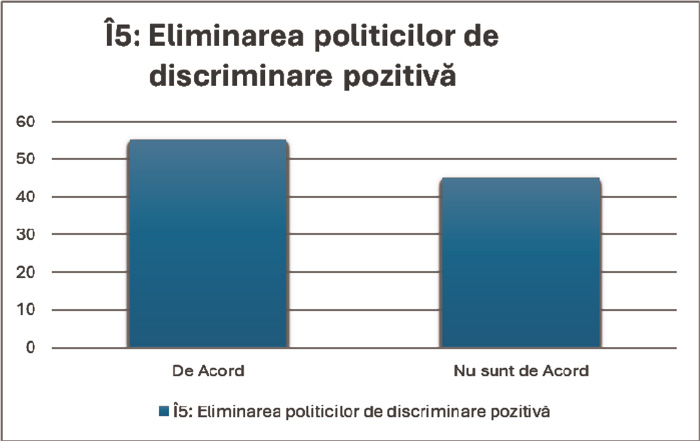
A mean score of 3.5 and the agreement of 55% of respondents suggest significant opposition to positive discrimination policies. The perception that these policies are unfair can fuel resentment and social tensions. It is important to clearly communicate the purpose and benefits of these policies to reduce perceptions of favoritism.
Question 6: Exploiting Minority Status
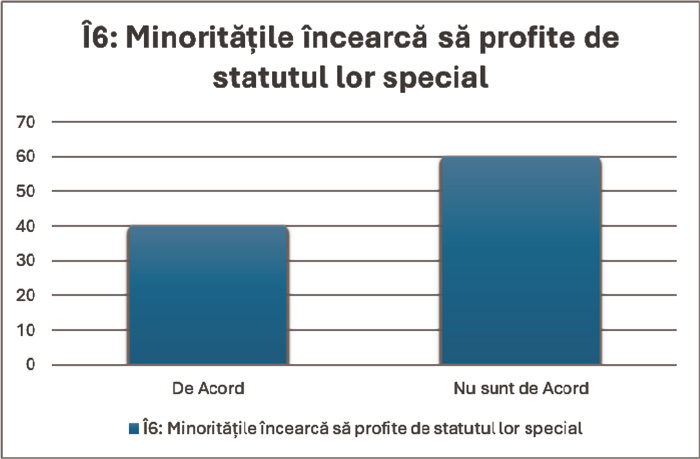
A mean score of 3.2 and the agreement of 40% of respondents suggest a perception of exploiting minority status for unjustified advantages. This perception can fuel negative stereotypes and prejudices, negatively impacting social cohesion and inter-ethnic relations.
Question 15: General Perception of Ethnic Minorities

Approximately 45% of respondents hold a positive or neutral opinion about ethnic minorities in Romania, while 55% have a negative opinion. The predominantly negative general perception reflects the presence of prejudices and aversive attitudes that can lead to discrimination and social exclusion of minorities.
Conclusions of the Study
The results of this quantitative study alarmingly highlight the persistence of aversive racism attitudes among the majority population in the investigated counties. The data reveal that a significant segment of the surveyed sample holds negative perspectives and prejudices against ethnic minorities, manifested through beliefs in unjustified preferential treatment and improper access to resources.
Over 60% of respondents believe that minorities receive too many rights, social benefits, or university placements at the expense of the majority. This perception distorts reality and creates a dangerous social tension. Resentments turn into hostile attitudes towards minorities, which are seen as responsible for their own lack of opportunities. For example, many respondents believe that Roma individuals receive university placements without merit, while Romanians are unfairly rejected.
Approximately 35-45% of respondents think that minorities “steal” jobs from Romanians. This perception is not only incorrect but also contributes to an atmosphere of suspicion and rivalry in the workplace. Instead of viewing diversity as an asset, these individuals perceive the presence of minorities as a direct threat to their economic stability. Minority employees are viewed with hostility and are often excluded from social circles at work.
Feelings of cultural threat are also pervasive. About 55% of respondents believe that ethnic minorities threaten traditional Romanian culture. This is manifested through refusal to participate in cultural events organized by minorities and criticism of these events in the public sphere. For example, Roma cultural festivals or events organized by Muslim communities are viewed with suspicion and are often criticized in the media and on social networks.
These negative perspectives are characteristic of aversive racism, defined by the perception of an unjustified success of another ethnic group. In the current social context in Romania, these subtle but deeply ingrained prejudices affect social cohesion and perpetuate inequities. Although not always manifested through violence or overt discrimination, these attitudes contribute to the exclusion and marginalization of minorities.
This study reveals that aversive racism is still present in Romanian society and that urgent and concrete measures are needed to combat it. It is essential to adopt a holistic approach that includes education, public policies, and community initiatives to create a more inclusive and equitable society for all its citizens. Ignoring these issues only perpetuates inequities and social tensions, undermining progress towards a truly egalitarian society. Romania faces a major challenge in addressing these attitudes, and success depends on the collective commitment of the government, non-governmental organizations, and every individual citizen.
General Conclusions
Aversive racism is a scientific social theory proposed by Samuel L. Gaertner and John F. Dovidio in 1986, which suggests that negative evaluations of racial and ethnic minorities are manifested through constant avoidance of interaction with these groups. Unlike traditional and overt racism, which involves hatred and direct discrimination against racial and ethnic minorities, aversive racism is characterized by more complex and ambivalent attitudes and expressions, including prejudiced opinions about other races. This type of racism originates from unconscious personal beliefs formed during childhood. African Americans are often targets of subtle racist behaviors. Workplace discrimination represents one of the most evident examples of aversive racism, where biased beliefs about how minorities act and think influence interactions between individuals and minority members.
Aversive racism represents a subtle and subconscious form of prejudice, which can manifest in behaviors, judgments, and decisions that favor or disadvantage certain ethnic groups, without individuals being aware of these tendencies. Aversion or negative feelings toward other groups can be unconsciously internalized, leading to a dissonance between an individual’s declared egalitarian values and their discriminatory behavior.
One critical aspect of aversive racism is that it can persist despite social and legal advances in combating discrimination. Many people express support for diversity and equality, but subconsciously may act discriminatorily when making decisions related to employment, housing, access to services, or other social aspects. This has been highlighted in the present study, where the majority of respondents exhibited aversive attitudes toward minorities.
The current analysis highlights the presence of aversive racism perspectives among the surveyed majority population, manifested in ideas such as preferential access to resources for minorities or cultural threats. Approximately 60% of respondents believe that minorities receive too many rights and social benefits, while 45% feel culturally threatened by minority values. These perceptions reflect a significant reluctance towards minority inclusion and suggest the need for more rigorous educational and legislative measures.
Recommendations
1. Intercultural Education: Implement programs of intercultural education in schools and universities to promote understanding and respect for diversity.
2. Awareness Campaigns: Launch public awareness campaigns to highlight the negative impact of prejudices and the benefits of an inclusive society.
3. Anti-Discrimination Legislation: Strengthen anti-discrimination legislation and ensure its strict enforcement to protect the rights of all citizens.
4. Promotion of Intergroup Dialogue: Create opportunities for dialogue and interaction between different ethnic groups to reduce prejudices and improve interethnic relations.
Combating aversive racism requires concerted efforts from all sectors of society. Only through education, legislation, and the promotion of a culture of respect and mutual understanding can we create a society where every individual is treated with dignity and respect, regardless of their ethnic background or race.
References
Ankur Joshi, Saket Kale, Satish Chandel, Dinesh Kumar Pal, “Likert Scale: Explored and Explained”, British Journal of Applied Science & Technology 7(4) (2015).
Creswell. J.W. and Creswell, J.D., “Research Design: Qualitative, Quantitative, and Mixed Methods Approaches” (2017 https://www.ucg.ac.me/skladiste/blog_609332/objava_105202/fajlovi/Creswell.pdf, accesat în 10.09.2024.
Dixon John., Durrheim Kevin., Tredoux Colin., Tropp Linda, Clack Beverly., Eaton Liberty. “A paradox of integration? Interracial contact, prejudice reduction and black South Africans’ perceptions of racial discrimination”, Journal of Social Issues, 66(2), (2010).
John F. Dovidio and Samuel L. “The Pernicious Nature of Contemporary Racism”, The Nonprofit Quarterly, 12(4), (2005).
John F. Dovidio, Samuel L. Gaertner, Tamar Saguy, “Another view of “we”: Majority and minority group perspectives on a common ingroup identity”, European Review of Social Psychology, 18 (2007).
Victoria M Esses, John F. Dovidio, Lynne M. Jackson, Tamara L. Armstrong, “The Immigration Dilemma: The Role of Perceived Group Competition, Ethnic Prejudice, and National Identity”, Journal of Social Issues 57(3), (2001).
Victoria M. Esses, John F. Dovidio, Antoinette H. Semenya, Lynne M. Jacksonattitudes, Attitudes Toward Immigrants and Immigration: The Role of National and International Identity, (London: Psychology Press, 2005).
NOTE
[1] John F. Dovidio and Samuel L. Gaertner, “Color Blind or Just Plain Blind? The Pernicious Nature of Contemporary Racism”. The Nonprofit Quarterly, 12(4), (2005): 40-46.
[2] John F. Dovidio, Samuel L. Gaertner, Tamar Saguy, “Another view of “we”: Majority and minority group perspectives on a common ingroup identity”, European Review of Social Psychology, 18 (2007): 296-330.
[3] John F. Dovidio, Samuel L. Gaertner, Tamar Saguy, “Another view”, 296-330.
[4] John F. Dovidio, Samuel L. Gaertner, Tamar Saguy, “Another view”, 296-330.
[5] John F. Dovidio, Samuel L. Gaertner, Tamar Saguy, “Another view”, 296-330.
[6] Victoria M. Esses, John F. Dovidio, Antoinette H. Semenya, Lynne M. Jacksonattitudes, Attitudes Toward Immigrants and Immigration: The Role of National and International Identity, (London: Psychology Press, 2005), 317-337.
[7] Dixon John., Durrheim Kevin., Tredoux Colin., Tropp Linda, Clack Beverly., Eaton Liberty. “A paradox of integration? Interracial contact, prejudice reduction and black South Africans’ perceptions of racial discrimination”, Journal of Social Issues, 66(2), (2010): 40-416.
[8] Victoria M Esses, John F. Dovidio, Lynne M. Jackson, Tamara L. Armstrong, “The Immigration Dilemma: The Role of Perceived Group Competition, Ethnic Prejudice, and National Identity”, Journal of Social Issues 57(3), (2001): 389 – 412
[9] Creswell. J.W. and Creswell, J.D., “Research Design: Qualitative, Quantitative, and Mixed Methods Approache” (2017) https://www.ucg.ac.me/skladiste/blog_609332/objava_105202/fajlovi/Creswell.pdf.
[10] Ankur Joshi, Saket Kale, Satish Chandel, Dinesh Kumar Pal, “Likert Scale: Explored and Explained” British Journal of Applied Science & Technology 7(4) (2015): 396-403.


